On June 18, Jing Zhang has succesfully defended her PhD Thesis on “Semantic Change Detection in Multitemporal Remote Sensing Images Using Deep Neural Networks”..
Congratulations to Jing!
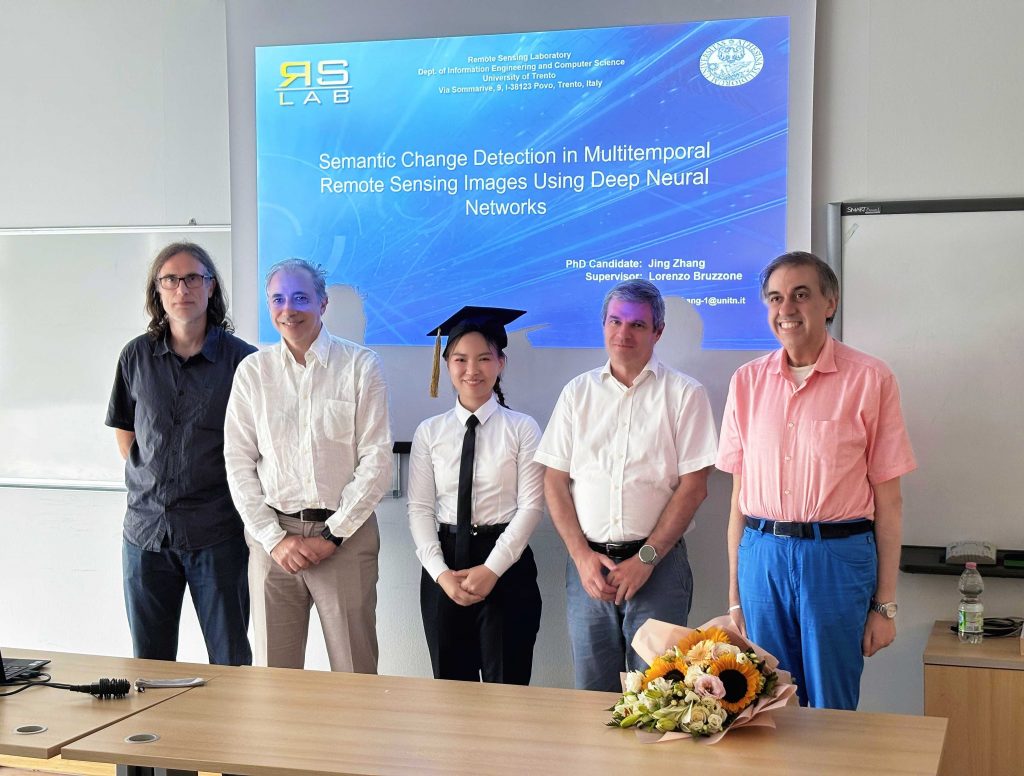
| ( ! ) Warning: Trying to access array offset on null in /var/www/html/wp-site/wp-content/themes/fizz/category-news.php on line 75 | ||||
|---|---|---|---|---|
| Call Stack | ||||
| # | Time | Memory | Function | Location |
| 1 | 0.0001 | 458424 | {main}( ) | .../index.php:0 |
| 2 | 0.0001 | 458776 | require( '/var/www/html/wp-site/wp-blog-header.php ) | .../index.php:17 |
| 3 | 0.0824 | 4572424 | require_once( '/var/www/html/wp-site/wp-includes/template-loader.php ) | .../wp-blog-header.php:19 |
| 4 | 0.0835 | 4599080 | include( '/var/www/html/wp-site/wp-content/themes/fizz/category-news.php ) | .../template-loader.php:125 |
| ( ! ) Deprecated: strcmp(): Passing null to parameter #1 ($string1) of type string is deprecated in /var/www/html/wp-site/wp-content/themes/fizz/category-news.php on line 75 | ||||
|---|---|---|---|---|
| Call Stack | ||||
| # | Time | Memory | Function | Location |
| 1 | 0.0001 | 458424 | {main}( ) | .../index.php:0 |
| 2 | 0.0001 | 458776 | require( '/var/www/html/wp-site/wp-blog-header.php ) | .../index.php:17 |
| 3 | 0.0824 | 4572424 | require_once( '/var/www/html/wp-site/wp-includes/template-loader.php ) | .../wp-blog-header.php:19 |
| 4 | 0.0835 | 4599080 | include( '/var/www/html/wp-site/wp-content/themes/fizz/category-news.php ) | .../template-loader.php:125 |
| 5 | 0.1368 | 5462912 | strcmp( $string1 = NULL, $string2 = 'true' ) | .../category-news.php:75 |
On June 18, Jing Zhang has succesfully defended her PhD Thesis on “Semantic Change Detection in Multitemporal Remote Sensing Images Using Deep Neural Networks”..
Congratulations to Jing!

| ( ! ) Warning: Trying to access array offset on null in /var/www/html/wp-site/wp-content/themes/fizz/category-news.php on line 75 | ||||
|---|---|---|---|---|
| Call Stack | ||||
| # | Time | Memory | Function | Location |
| 1 | 0.0001 | 458424 | {main}( ) | .../index.php:0 |
| 2 | 0.0001 | 458776 | require( '/var/www/html/wp-site/wp-blog-header.php ) | .../index.php:17 |
| 3 | 0.0824 | 4572424 | require_once( '/var/www/html/wp-site/wp-includes/template-loader.php ) | .../wp-blog-header.php:19 |
| 4 | 0.0835 | 4599080 | include( '/var/www/html/wp-site/wp-content/themes/fizz/category-news.php ) | .../template-loader.php:125 |
| ( ! ) Deprecated: strcmp(): Passing null to parameter #1 ($string1) of type string is deprecated in /var/www/html/wp-site/wp-content/themes/fizz/category-news.php on line 75 | ||||
|---|---|---|---|---|
| Call Stack | ||||
| # | Time | Memory | Function | Location |
| 1 | 0.0001 | 458424 | {main}( ) | .../index.php:0 |
| 2 | 0.0001 | 458776 | require( '/var/www/html/wp-site/wp-blog-header.php ) | .../index.php:17 |
| 3 | 0.0824 | 4572424 | require_once( '/var/www/html/wp-site/wp-includes/template-loader.php ) | .../wp-blog-header.php:19 |
| 4 | 0.0835 | 4599080 | include( '/var/www/html/wp-site/wp-content/themes/fizz/category-news.php ) | .../template-loader.php:125 |
| 5 | 0.1394 | 5488256 | strcmp( $string1 = NULL, $string2 = 'true' ) | .../category-news.php:75 |
RSLab is looking for strongly motivated candidate PhD students having excellent study career and interested in research activities in artificial intelligence, remote sensing and radar in the context
of Earth observation and/or planetary exploration. Applications in the framework of the PhD Program in Information Engineering and Computer Science at the University of Trento are open under Area D on the following specific topics:
Closing date: August 22, 2025, hrs. 4.00 PM (CEST)
Duration: 3 years.
More information at IECS doctoral school webage

| ( ! ) Warning: Trying to access array offset on null in /var/www/html/wp-site/wp-content/themes/fizz/category-news.php on line 75 | ||||
|---|---|---|---|---|
| Call Stack | ||||
| # | Time | Memory | Function | Location |
| 1 | 0.0001 | 458424 | {main}( ) | .../index.php:0 |
| 2 | 0.0001 | 458776 | require( '/var/www/html/wp-site/wp-blog-header.php ) | .../index.php:17 |
| 3 | 0.0824 | 4572424 | require_once( '/var/www/html/wp-site/wp-includes/template-loader.php ) | .../wp-blog-header.php:19 |
| 4 | 0.0835 | 4599080 | include( '/var/www/html/wp-site/wp-content/themes/fizz/category-news.php ) | .../template-loader.php:125 |
| ( ! ) Deprecated: strcmp(): Passing null to parameter #1 ($string1) of type string is deprecated in /var/www/html/wp-site/wp-content/themes/fizz/category-news.php on line 75 | ||||
|---|---|---|---|---|
| Call Stack | ||||
| # | Time | Memory | Function | Location |
| 1 | 0.0001 | 458424 | {main}( ) | .../index.php:0 |
| 2 | 0.0001 | 458776 | require( '/var/www/html/wp-site/wp-blog-header.php ) | .../index.php:17 |
| 3 | 0.0824 | 4572424 | require_once( '/var/www/html/wp-site/wp-includes/template-loader.php ) | .../wp-blog-header.php:19 |
| 4 | 0.0835 | 4599080 | include( '/var/www/html/wp-site/wp-content/themes/fizz/category-news.php ) | .../template-loader.php:125 |
| 5 | 0.1421 | 5491264 | strcmp( $string1 = NULL, $string2 = 'true' ) | .../category-news.php:75 |
A major milestone has been reached by RIME (Radar for Icy Moon Exploration), the radar sounder aboard ESA’s JUICE (JUpiter ICy Moon Explorer) mission: its first focused radargram has been successfully generated.
This achievement confirms that RIME is functioning as expected, delivering high-quality radar data — a key step forward in preparing the instrument for its primary science phase at Jupiter’s icy moons.
The radargram was produced using data collected during a lunar flyby in August 2024. Remarkably, the region of the Moon scanned by RIME is the same area captured in the iconic “Earthrise” photograph taken by NASA astronaut William Anders during the Apollo 8 mission in 1968 — now seen from a completely new perspective.
🔗 Learn more:
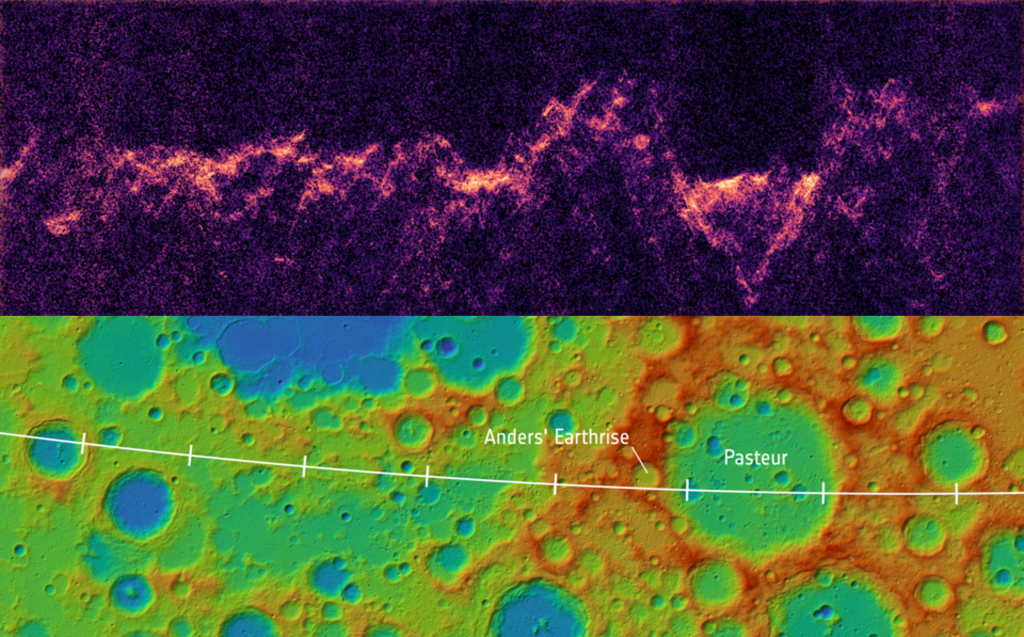
| ( ! ) Warning: Trying to access array offset on null in /var/www/html/wp-site/wp-content/themes/fizz/category-news.php on line 75 | ||||
|---|---|---|---|---|
| Call Stack | ||||
| # | Time | Memory | Function | Location |
| 1 | 0.0001 | 458424 | {main}( ) | .../index.php:0 |
| 2 | 0.0001 | 458776 | require( '/var/www/html/wp-site/wp-blog-header.php ) | .../index.php:17 |
| 3 | 0.0824 | 4572424 | require_once( '/var/www/html/wp-site/wp-includes/template-loader.php ) | .../wp-blog-header.php:19 |
| 4 | 0.0835 | 4599080 | include( '/var/www/html/wp-site/wp-content/themes/fizz/category-news.php ) | .../template-loader.php:125 |
| ( ! ) Deprecated: strcmp(): Passing null to parameter #1 ($string1) of type string is deprecated in /var/www/html/wp-site/wp-content/themes/fizz/category-news.php on line 75 | ||||
|---|---|---|---|---|
| Call Stack | ||||
| # | Time | Memory | Function | Location |
| 1 | 0.0001 | 458424 | {main}( ) | .../index.php:0 |
| 2 | 0.0001 | 458776 | require( '/var/www/html/wp-site/wp-blog-header.php ) | .../index.php:17 |
| 3 | 0.0824 | 4572424 | require_once( '/var/www/html/wp-site/wp-includes/template-loader.php ) | .../wp-blog-header.php:19 |
| 4 | 0.0835 | 4599080 | include( '/var/www/html/wp-site/wp-content/themes/fizz/category-news.php ) | .../template-loader.php:125 |
| 5 | 0.1451 | 5510664 | strcmp( $string1 = NULL, $string2 = 'true' ) | .../category-news.php:75 |
On May 5–6, 2025, the RIME (Radar for Icy Moons Exploration) Science Team gathered to review progress and plan next steps for the radar instrument aboard ESA’s JUICE mission.
The meeting highlighted recent scientific and operational developments, including the successful activities carried out during the Lunar-Earth Gravity Assist—a key milestone that tested RIME’s systems and operations.
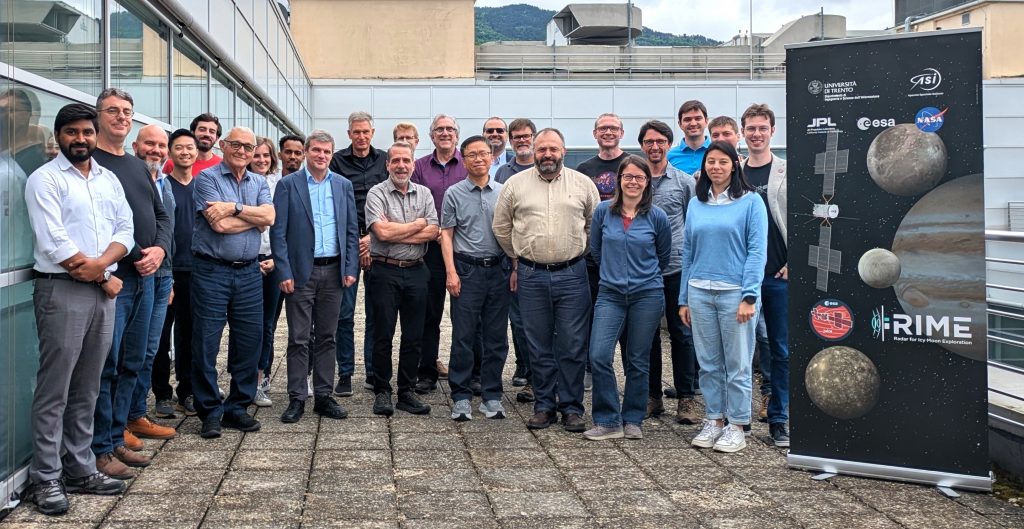
| ( ! ) Warning: Trying to access array offset on null in /var/www/html/wp-site/wp-content/themes/fizz/category-news.php on line 75 | ||||
|---|---|---|---|---|
| Call Stack | ||||
| # | Time | Memory | Function | Location |
| 1 | 0.0001 | 458424 | {main}( ) | .../index.php:0 |
| 2 | 0.0001 | 458776 | require( '/var/www/html/wp-site/wp-blog-header.php ) | .../index.php:17 |
| 3 | 0.0824 | 4572424 | require_once( '/var/www/html/wp-site/wp-includes/template-loader.php ) | .../wp-blog-header.php:19 |
| 4 | 0.0835 | 4599080 | include( '/var/www/html/wp-site/wp-content/themes/fizz/category-news.php ) | .../template-loader.php:125 |
| ( ! ) Deprecated: strcmp(): Passing null to parameter #1 ($string1) of type string is deprecated in /var/www/html/wp-site/wp-content/themes/fizz/category-news.php on line 75 | ||||
|---|---|---|---|---|
| Call Stack | ||||
| # | Time | Memory | Function | Location |
| 1 | 0.0001 | 458424 | {main}( ) | .../index.php:0 |
| 2 | 0.0001 | 458776 | require( '/var/www/html/wp-site/wp-blog-header.php ) | .../index.php:17 |
| 3 | 0.0824 | 4572424 | require_once( '/var/www/html/wp-site/wp-includes/template-loader.php ) | .../wp-blog-header.php:19 |
| 4 | 0.0835 | 4599080 | include( '/var/www/html/wp-site/wp-content/themes/fizz/category-news.php ) | .../template-loader.php:125 |
| 5 | 0.1476 | 5508576 | strcmp( $string1 = NULL, $string2 = 'true' ) | .../category-news.php:75 |
On April 17, Raktim Ghosh has succesfully defended cum laude his PhD Thesis on “Novel Architectures for Radar Sounder Signals Segmentation: From Convolutional Neural Networks to Quantum-enhanced Networks”.
Congratulations to Raktim!
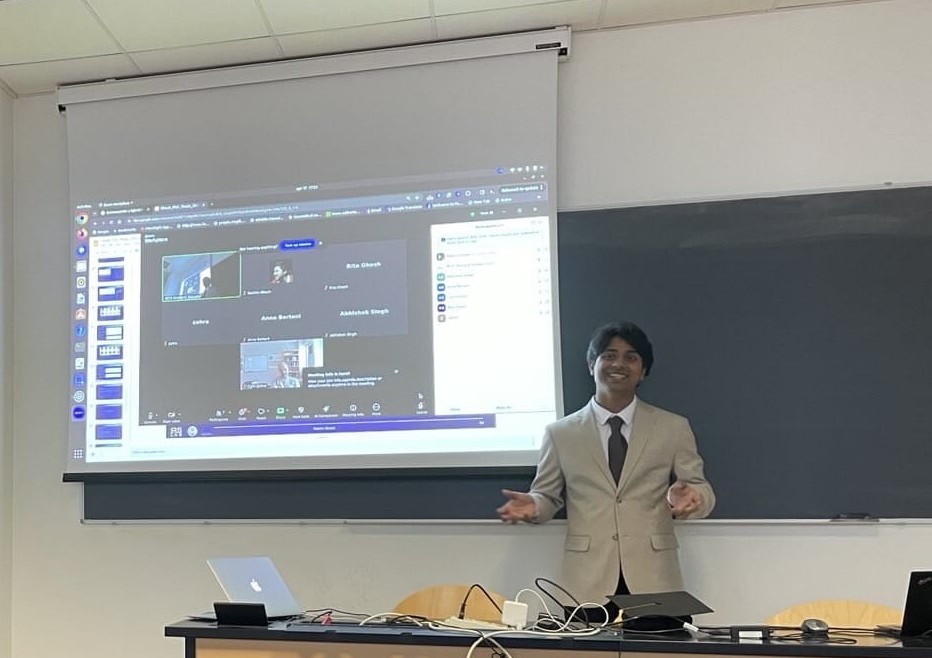
| ( ! ) Warning: Trying to access array offset on null in /var/www/html/wp-site/wp-content/themes/fizz/category-news.php on line 75 | ||||
|---|---|---|---|---|
| Call Stack | ||||
| # | Time | Memory | Function | Location |
| 1 | 0.0001 | 458424 | {main}( ) | .../index.php:0 |
| 2 | 0.0001 | 458776 | require( '/var/www/html/wp-site/wp-blog-header.php ) | .../index.php:17 |
| 3 | 0.0824 | 4572424 | require_once( '/var/www/html/wp-site/wp-includes/template-loader.php ) | .../wp-blog-header.php:19 |
| 4 | 0.0835 | 4599080 | include( '/var/www/html/wp-site/wp-content/themes/fizz/category-news.php ) | .../template-loader.php:125 |
| ( ! ) Deprecated: strcmp(): Passing null to parameter #1 ($string1) of type string is deprecated in /var/www/html/wp-site/wp-content/themes/fizz/category-news.php on line 75 | ||||
|---|---|---|---|---|
| Call Stack | ||||
| # | Time | Memory | Function | Location |
| 1 | 0.0001 | 458424 | {main}( ) | .../index.php:0 |
| 2 | 0.0001 | 458776 | require( '/var/www/html/wp-site/wp-blog-header.php ) | .../index.php:17 |
| 3 | 0.0824 | 4572424 | require_once( '/var/www/html/wp-site/wp-includes/template-loader.php ) | .../wp-blog-header.php:19 |
| 4 | 0.0835 | 4599080 | include( '/var/www/html/wp-site/wp-content/themes/fizz/category-news.php ) | .../template-loader.php:125 |
| 5 | 0.1494 | 5527992 | strcmp( $string1 = NULL, $string2 = 'true' ) | .../category-news.php:75 |
Khatereh Meshkini received the 2024 “Frank Marzano” award for the Best Italian PhD Theses on Geoscience and Remote Sensing by the Italian Chapter of the IEEE Geoscience and Remote Sensing Society. Continue Reading
| ( ! ) Warning: Trying to access array offset on null in /var/www/html/wp-site/wp-content/themes/fizz/category-news.php on line 75 | ||||
|---|---|---|---|---|
| Call Stack | ||||
| # | Time | Memory | Function | Location |
| 1 | 0.0001 | 458424 | {main}( ) | .../index.php:0 |
| 2 | 0.0001 | 458776 | require( '/var/www/html/wp-site/wp-blog-header.php ) | .../index.php:17 |
| 3 | 0.0824 | 4572424 | require_once( '/var/www/html/wp-site/wp-includes/template-loader.php ) | .../wp-blog-header.php:19 |
| 4 | 0.0835 | 4599080 | include( '/var/www/html/wp-site/wp-content/themes/fizz/category-news.php ) | .../template-loader.php:125 |
| ( ! ) Deprecated: strcmp(): Passing null to parameter #1 ($string1) of type string is deprecated in /var/www/html/wp-site/wp-content/themes/fizz/category-news.php on line 75 | ||||
|---|---|---|---|---|
| Call Stack | ||||
| # | Time | Memory | Function | Location |
| 1 | 0.0001 | 458424 | {main}( ) | .../index.php:0 |
| 2 | 0.0001 | 458776 | require( '/var/www/html/wp-site/wp-blog-header.php ) | .../index.php:17 |
| 3 | 0.0824 | 4572424 | require_once( '/var/www/html/wp-site/wp-includes/template-loader.php ) | .../wp-blog-header.php:19 |
| 4 | 0.0835 | 4599080 | include( '/var/www/html/wp-site/wp-content/themes/fizz/category-news.php ) | .../template-loader.php:125 |
| 5 | 0.1507 | 5533624 | strcmp( $string1 = NULL, $string2 = 'true' ) | .../category-news.php:75 |
The HRLC CCI studies and investigates the role of the spatial resolution of land cover and land cover change in supporting climate modelling research at regional scale in key climatic areas in Africa, South America and Siberia. During Phase 1 of the programme, the Consortium generated and validate land cover maps and land cover change using Earth Observation data acquired over the last decades, from 1990 to 2019. This enables the study of land cover and land cover change and their impact on Earth Climate at regional scale using high spatial resolution Earth Observation data (i.e., 10-30 m).
In Phase 2, the HRLC project aims at updating the historical time series of land cover maps at 30m resolution from 1990 to 2019 with the maps for 2024. Moreover, the products for the mapped area in South America will be extended to the full Amazon river basin, paving the way towards continental-scale climate modelling at high resolution!
| ( ! ) Warning: Trying to access array offset on null in /var/www/html/wp-site/wp-content/themes/fizz/category-news.php on line 75 | ||||
|---|---|---|---|---|
| Call Stack | ||||
| # | Time | Memory | Function | Location |
| 1 | 0.0001 | 458424 | {main}( ) | .../index.php:0 |
| 2 | 0.0001 | 458776 | require( '/var/www/html/wp-site/wp-blog-header.php ) | .../index.php:17 |
| 3 | 0.0824 | 4572424 | require_once( '/var/www/html/wp-site/wp-includes/template-loader.php ) | .../wp-blog-header.php:19 |
| 4 | 0.0835 | 4599080 | include( '/var/www/html/wp-site/wp-content/themes/fizz/category-news.php ) | .../template-loader.php:125 |
| ( ! ) Deprecated: strcmp(): Passing null to parameter #1 ($string1) of type string is deprecated in /var/www/html/wp-site/wp-content/themes/fizz/category-news.php on line 75 | ||||
|---|---|---|---|---|
| Call Stack | ||||
| # | Time | Memory | Function | Location |
| 1 | 0.0001 | 458424 | {main}( ) | .../index.php:0 |
| 2 | 0.0001 | 458776 | require( '/var/www/html/wp-site/wp-blog-header.php ) | .../index.php:17 |
| 3 | 0.0824 | 4572424 | require_once( '/var/www/html/wp-site/wp-includes/template-loader.php ) | .../wp-blog-header.php:19 |
| 4 | 0.0835 | 4599080 | include( '/var/www/html/wp-site/wp-content/themes/fizz/category-news.php ) | .../template-loader.php:125 |
| 5 | 0.1536 | 5539440 | strcmp( $string1 = NULL, $string2 = 'true' ) | .../category-news.php:75 |
The 2024 was a very dense and exciting year at RSLab UniTrento with different activities on both Earth Observation and Planetary Exploration. RSLab has the leadership of important projects (e.g., the radar for icy moon exploration (RIME) currently in the cruise phase toward the Jupiter system on the ESA JUICE mission, the subsurface radar sounder (SRS) on the ESA EnVision mission to be launched to Venus in 2031, the ESA Climate Change Initiative High Resolution Land Cover project) and is involved in many other research initiatives.
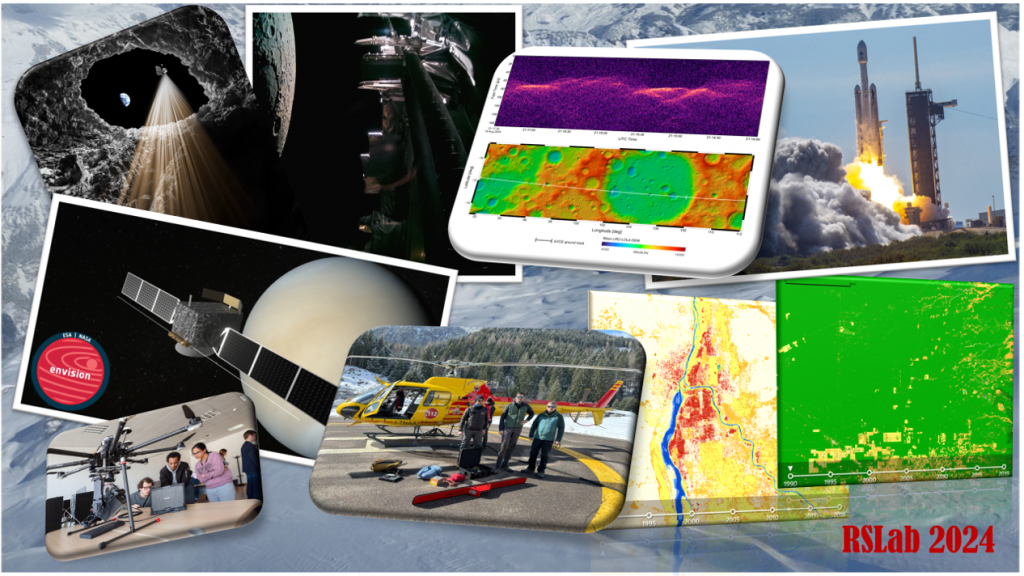
Below a summary of RSLab in numbers in 2024:
• 35 papers published on peer-reviewed international journals
• 5600+ (Source: Google Scholar) / 4800+ (Source: Scopus) citations
• PI-ship/ Coordination of 3 international projects
• Partnership in 4 international and 6 national projects
• Top positions of the Lab in international ranking of research
• 4 awards
• 5 graduated PhD students
• 150+ public outreach activities (i.e., international and national tv, radio, newspaper and magazine interviews)
For more details navigate on the news and the publication pages of this web site.
| ( ! ) Warning: Trying to access array offset on null in /var/www/html/wp-site/wp-content/themes/fizz/category-news.php on line 75 | ||||
|---|---|---|---|---|
| Call Stack | ||||
| # | Time | Memory | Function | Location |
| 1 | 0.0001 | 458424 | {main}( ) | .../index.php:0 |
| 2 | 0.0001 | 458776 | require( '/var/www/html/wp-site/wp-blog-header.php ) | .../index.php:17 |
| 3 | 0.0824 | 4572424 | require_once( '/var/www/html/wp-site/wp-includes/template-loader.php ) | .../wp-blog-header.php:19 |
| 4 | 0.0835 | 4599080 | include( '/var/www/html/wp-site/wp-content/themes/fizz/category-news.php ) | .../template-loader.php:125 |
| ( ! ) Deprecated: strcmp(): Passing null to parameter #1 ($string1) of type string is deprecated in /var/www/html/wp-site/wp-content/themes/fizz/category-news.php on line 75 | ||||
|---|---|---|---|---|
| Call Stack | ||||
| # | Time | Memory | Function | Location |
| 1 | 0.0001 | 458424 | {main}( ) | .../index.php:0 |
| 2 | 0.0001 | 458776 | require( '/var/www/html/wp-site/wp-blog-header.php ) | .../index.php:17 |
| 3 | 0.0824 | 4572424 | require_once( '/var/www/html/wp-site/wp-includes/template-loader.php ) | .../wp-blog-header.php:19 |
| 4 | 0.0835 | 4599080 | include( '/var/www/html/wp-site/wp-content/themes/fizz/category-news.php ) | .../template-loader.php:125 |
| 5 | 0.1557 | 5557648 | strcmp( $string1 = NULL, $string2 = 'true' ) | .../category-news.php:75 |
During the first in history gravity assist flyby of the Earth-Moon system, which took place successfully between August 19 and 20, the Radar for Icy Moon Exploration (RIME) was activated and performed a wide range of tests.
During the lunar flyby, RIME was operated to acquire, for the first time since the launch of JUICE, data from the surface of a celestial body. Tests were performed by varying the radar parameters with the aim of better characterizing the functioning of RIME. First analyses of the data show that the instrument is functioning properly and resulted in the generation of the first unfocused RIME radargramme.
During the Earth flyby, RIME was operated in listen-only mode for both measuring radio signals generated by terrestrial transmissions that are useful for calibration and providing data on the Earth’s ionosphere.
More details here and on some of the media coverage reported below.
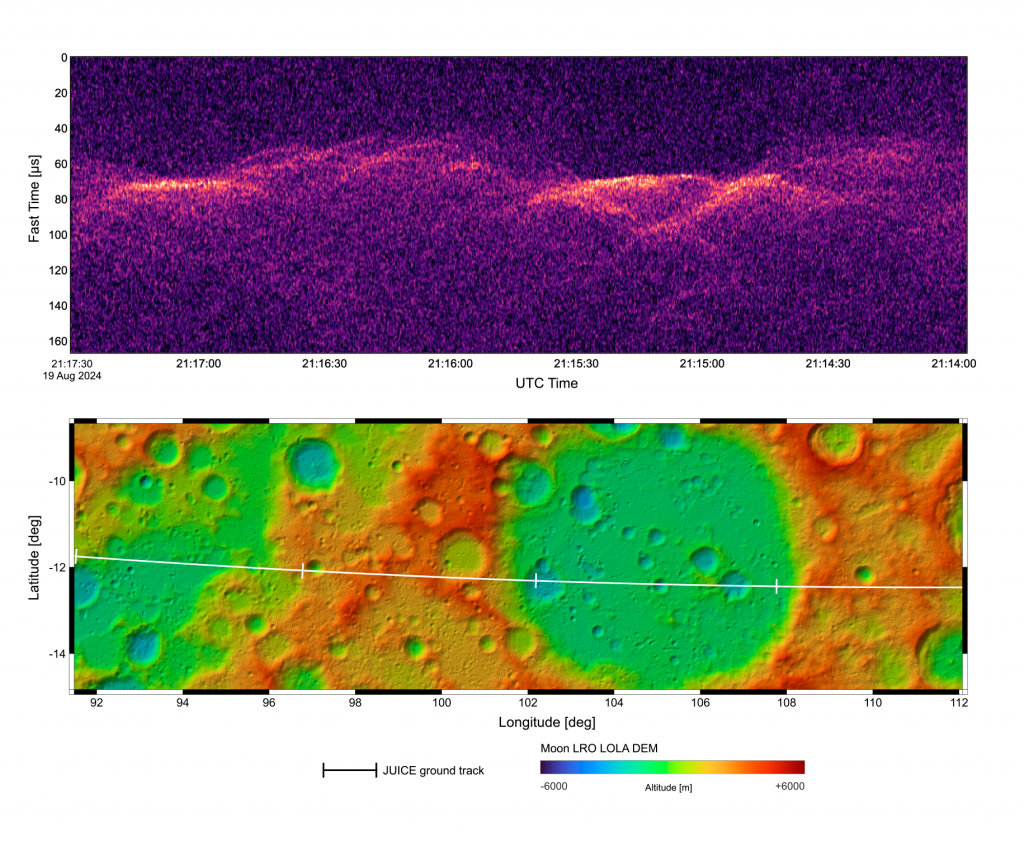 The image presents the first RIME radrgramme the lunar surface and the digital elevation model (DEM) of the area with the spacecraft groundtrack indicated by a white line. The radargram has been generated with preliminary pre-processing (RFI noise mitigation, range compression and simple pre-summing only) and is not focused yet. It shows the surface of the Moon in the area of the flyby, which is a very rough area characterized by large variations of topography as shown in the DEM.
The image presents the first RIME radrgramme the lunar surface and the digital elevation model (DEM) of the area with the spacecraft groundtrack indicated by a white line. The radargram has been generated with preliminary pre-processing (RFI noise mitigation, range compression and simple pre-summing only) and is not focused yet. It shows the surface of the Moon in the area of the flyby, which is a very rough area characterized by large variations of topography as shown in the DEM.
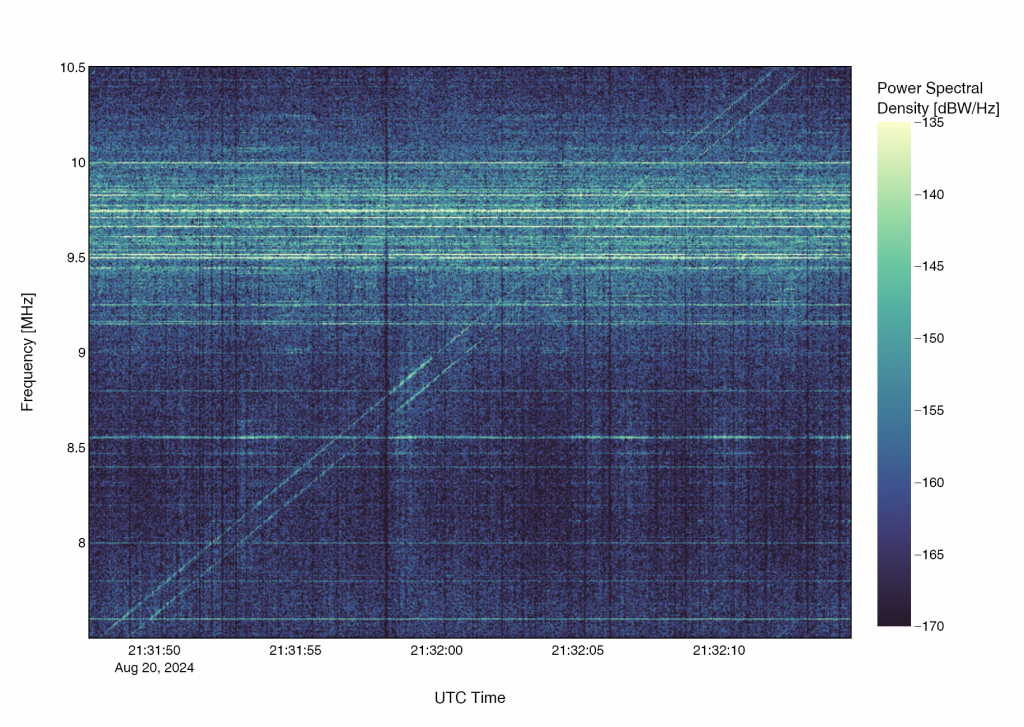 Spectrogram measured by the RIME in listen-only mode during part of the flyby of the Earth. Many different radio frequency sources are detected and visible in the data.
Spectrogram measured by the RIME in listen-only mode during part of the flyby of the Earth. Many different radio frequency sources are detected and visible in the data.
| ( ! ) Warning: Trying to access array offset on null in /var/www/html/wp-site/wp-content/themes/fizz/category-news.php on line 75 | ||||
|---|---|---|---|---|
| Call Stack | ||||
| # | Time | Memory | Function | Location |
| 1 | 0.0001 | 458424 | {main}( ) | .../index.php:0 |
| 2 | 0.0001 | 458776 | require( '/var/www/html/wp-site/wp-blog-header.php ) | .../index.php:17 |
| 3 | 0.0824 | 4572424 | require_once( '/var/www/html/wp-site/wp-includes/template-loader.php ) | .../wp-blog-header.php:19 |
| 4 | 0.0835 | 4599080 | include( '/var/www/html/wp-site/wp-content/themes/fizz/category-news.php ) | .../template-loader.php:125 |
| ( ! ) Deprecated: strcmp(): Passing null to parameter #1 ($string1) of type string is deprecated in /var/www/html/wp-site/wp-content/themes/fizz/category-news.php on line 75 | ||||
|---|---|---|---|---|
| Call Stack | ||||
| # | Time | Memory | Function | Location |
| 1 | 0.0001 | 458424 | {main}( ) | .../index.php:0 |
| 2 | 0.0001 | 458776 | require( '/var/www/html/wp-site/wp-blog-header.php ) | .../index.php:17 |
| 3 | 0.0824 | 4572424 | require_once( '/var/www/html/wp-site/wp-includes/template-loader.php ) | .../wp-blog-header.php:19 |
| 4 | 0.0835 | 4599080 | include( '/var/www/html/wp-site/wp-content/themes/fizz/category-news.php ) | .../template-loader.php:125 |
| 5 | 0.1599 | 5568496 | strcmp( $string1 = NULL, $string2 = 'true' ) | .../category-news.php:75 |
Europa Clipper mission has launched on October 14th, 2024, toward the Jupiter moon Europa.
RSLab is part of the team of REASON (Radar for Europa Assessment and Sounding: Ocean to Near-surface), which is one of the main instruments on-board Europa Clipper. REASON is designed for probing Europa’s icy shell for the moon’s suspected ocean and studying the ice’s structure and thickness. The data acquired by REASON together with the data taken by RIME (Radar for Icy Mooon Exploration, under the RSLab leadership) on-board the ESA JUICE (Jupiter Icy Moons Explorer) spacecraft (currently in cruise toward the Jupiter system) will contribute to discover the subsurface world of the Jupiter icy moons, which is stimulating the imagination of scientists and science fiction since very long time.
The two radars, REASON and RIME, were conceived in the phase in which Juice and Europa Clipper were part of the joint EJSM mission (Europa Jupiter System Mission) which envisaged a close collaboration between ESA and NASA for the synergistic development of two probes, one from send into orbit around Ganymede (ESA’s) and the other around Europa (NASA’s). For programmatic reasons the joint mission was then separated into the two independent missions Europa Clipper and Juice, but the collaboration continued to optimize the complementarities and differences of the two radars and the related scientific objectives. With the launch of Europa Clipper, which follows that of Juice, the initial plan to have two probes dedicated to the study of Jupiter’s icy moons is effectively realized and completed.
Go Europa Clipper!
Below some samples from the coverage of the regional and national media.